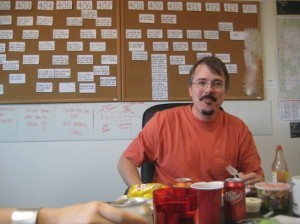The Case for Paper
There are so many kinds of writing software out there now that there’s really no reason for office supplies any more. And yet I don’t know any writer who works solely on her computer. I have friends who actually write the first draft in longhand (that would be Gaffney, for one) which boggles my mind, but even for writers like me who’d never write a story if she didn’t have a keyboard, working with pen and paper at some point feels crucial. My personal crutch is quad paper, those quarter inch squares freeing me from linearity; no matter how much I think I’ve organized things, sooner or later I go looking for the grid to free things up. And then of course there’s the dry erase board and it’s lower tech cousin, the cork board and 3×5 card. Moving to New Jersey has meant that I’ve lost both, and I’m to the point now where I’m going to have to remodel the garage into a living space because it’s the only place with walls big enough to handle the cork and dry erase I need.
And it’s evidently not just novelists who feel this way. This excerpt from an interview with Breaking Bad‘s executive producer, Peter Gould, about the way things worked in the writers’ room is a great example of the way cork and 3×5 work:
There’s a great advantage to doing things by hand as opposed to electronically. I know not all show runners or all rooms run this way, but we’re all sitting there. Some of us are doodling or doing crafts, but the thing that we’re focused on is a corkboard which has three-by-five cards pinned to it. You can actually see pictures of this on the internet. There are a few that I think I’ve shared on my Twitter stream. It’s divided into acts, and these cards are somewhat laborious to write so there’s a certain commitment that you make as you put each final card up. It’s a pain in the ass to change them, and I think that one of the things you really look for is to talk about it as much as you possibly can, and then you commit. You say, “OK, this is what the scene is.”
If you look at the picture above and the others from the article by Dustin Rowles on Uproxx, you’ll see they’re not really describing scenes but beats, which is something I hadn’t thought of but that really makes sense. It’s much more freeing to think in key moments than in scenes because it doesn’t lock you down into a structure; you’ve just got character up there on those cards. If I had a cork board, I’d be doing that now. Damn it. Back to Home Depot and Staples.
I’m not sure why we’re drawn to the I-need-to-touch-paper part of writing. I think part of it is that story looks different every time you change its context; I do part of my rewriting on paper (the direct opposite of Gaffney) because the story on the screen is not the same story that comes out of my printer. The words are the same but they look different, it’s my story made fresh and I can see the flaws that I missed on the screen. Another part may be the need to make the story physical, to make the scene a card, to feel the relationships between the scenes flow from the pen into arrows on the quad paper, to see the shape of the characters’ names as you print them on the page, which, come to think of it, may be why Gaffney has to write first drafts in long hand. But there may be something there that’s just atavistic, that need to get your hands on the clay so you can feel what you’ve been dreaming become physical. Brain to computer still feels like dreaming. Words on paper feel like story.
Or at least they do to me. Is working on the computer enough for you (whatever it is you do) or do you, too, feel the need to touch words on paper in some way?





